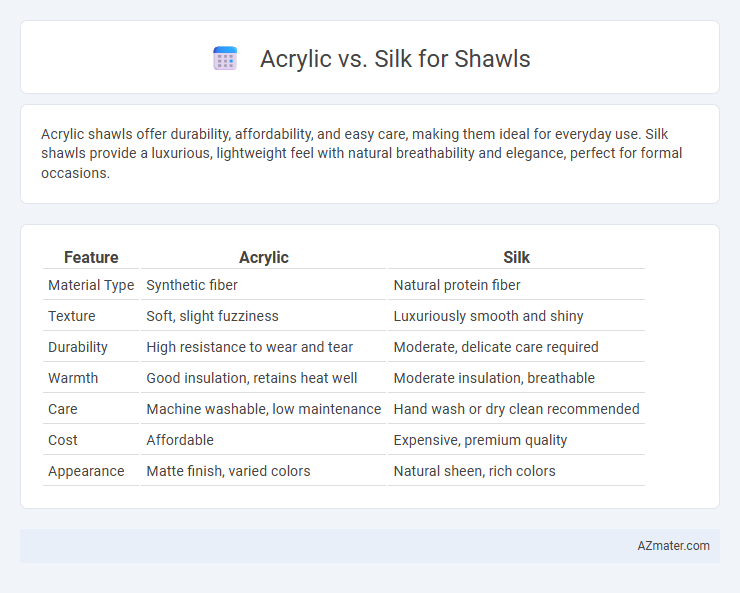Acrylic shawls offer durability, affordability, and easy care, making them ideal for everyday use. Silk shawls provide a luxurious, lightweight feel with natural breathability and elegance, perfect for formal occasions.
Table of Comparison
| Feature | Acrylic | Silk |
|---|---|---|
| Material Type | Synthetic fiber | Natural protein fiber |
| Texture | Soft, slight fuzziness | Luxuriously smooth and shiny |
| Durability | High resistance to wear and tear | Moderate, delicate care required |
| Warmth | Good insulation, retains heat well | Moderate insulation, breathable |
| Care | Machine washable, low maintenance | Hand wash or dry clean recommended |
| Cost | Affordable | Expensive, premium quality |
| Appearance | Matte finish, varied colors | Natural sheen, rich colors |
Introduction to Acrylic and Silk Shawls
Acrylic shawls offer durability, affordability, and easy maintenance, making them a popular synthetic choice for everyday wear. Silk shawls are prized for their natural sheen, softness, and breathable fabric, providing a luxurious and lightweight feel ideal for formal occasions. The key differences lie in their fiber origins--acrylic is a man-made polymer, while silk comes from the cocoon of the silkworm--impacting texture, warmth, and care requirements.
Key Differences Between Acrylic and Silk
Acrylic shawls are synthetic, lightweight, and affordable, offering durability and easy care, whereas silk shawls are natural, luxurious, and breathable with a smooth texture and elegant sheen. Acrylic provides better resistance to moisture and is often hypoallergenic, while silk excels in temperature regulation and has a delicate, high-end appearance. The key differences lie in fiber origin, comfort level, maintenance requirements, and price, influencing the choice between an economical option and a premium fabric.
Texture and Comfort Comparison
Acrylic shawls offer a soft, smooth texture that mimics wool but can feel slightly synthetic against the skin, while silk shawls provide a luxurious, natural smoothness with a cool, breathable touch ideal for sensitive skin. Silk's lightweight and hypoallergenic properties enhance comfort, making it suitable for prolonged wear, whereas acrylic's durability and resistance to wrinkles ensure easy maintenance despite less breathability. The choice depends on prioritizing the natural elegance and softness of silk versus the affordable warmth and practicality of acrylic.
Durability and Longevity
Acrylic shawls offer high durability with resistance to wear, fading, and moisture, making them ideal for frequent use and easy maintenance. Silk shawls, while luxurious and soft, require delicate care to maintain their longevity and are more prone to damage from abrasion and exposure to sunlight. Choosing acrylic ensures a longer-lasting shawl with less risk of fraying, whereas silk prioritizes elegance but demands careful handling to preserve its lifespan.
Warmth and Insulation Properties
Acrylic shawls offer excellent warmth due to their synthetic fibers, which trap heat effectively, making them suitable for cold weather. Silk shawls provide moderate insulation with natural temperature-regulating properties, allowing breathability while maintaining warmth. The insulating efficiency of acrylic typically surpasses silk, but silk's lightweight and moisture-wicking capabilities enhance comfort in varied climates.
Maintenance and Care Requirements
Acrylic shawls require low maintenance, as they are machine washable, resistant to wrinkles, and quick-drying, making them ideal for everyday use. Silk shawls demand delicate care, including hand washing or dry cleaning, and protection from direct sunlight to maintain their sheen and prevent fabric damage. Proper storage in a breathable bag is essential for silk shawls to avoid moisture and moth damage, while acrylic shawls are less sensitive and can be stored more casually.
Price and Affordability
Acrylic shawls are significantly more affordable than silk, making them accessible for budget-conscious buyers seeking stylish options. Silk shawls, crafted from natural fibers, tend to be pricier due to their luxurious texture and durability. The cost difference makes acrylic ideal for everyday wear while silk offers a premium choice suitable for special occasions.
Eco-Friendliness and Sustainability
Silk shawls are biodegradable and derived from natural fibers, contributing to eco-friendliness through renewable resources and minimal chemical use, but they require intensive water and energy during production. Acrylic shawls, made from synthetic polymers, are less sustainable due to reliance on fossil fuels and non-biodegradable waste, often contributing to microplastic pollution. Choosing silk supports renewable agriculture, whereas acrylic favors durability but poses greater environmental challenges in decomposition and resource extraction.
Style Versatility and Aesthetic Appeal
Acrylic shawls offer vibrant color retention and easy maintenance, making them ideal for bold, contemporary styles with affordable elegance. Silk shawls provide a natural sheen and luxurious drape, enhancing formal and classic aesthetics with a timeless appeal. Both materials cater to diverse fashion preferences, with acrylic excelling in durability and silk in refined texture and luster.
Choosing the Best Material for Your Shawl
Acrylic shawls offer affordability, durability, and easy care, making them ideal for everyday wear and vibrant color options. Silk shawls provide luxurious softness, natural breathability, and elegant drape, perfect for special occasions and sensitive skin. Choosing the best material depends on your priorities for comfort, maintenance, and the intended use of the shawl.

Infographic: Acrylic vs Silk for Shawl
 azmater.com
azmater.com